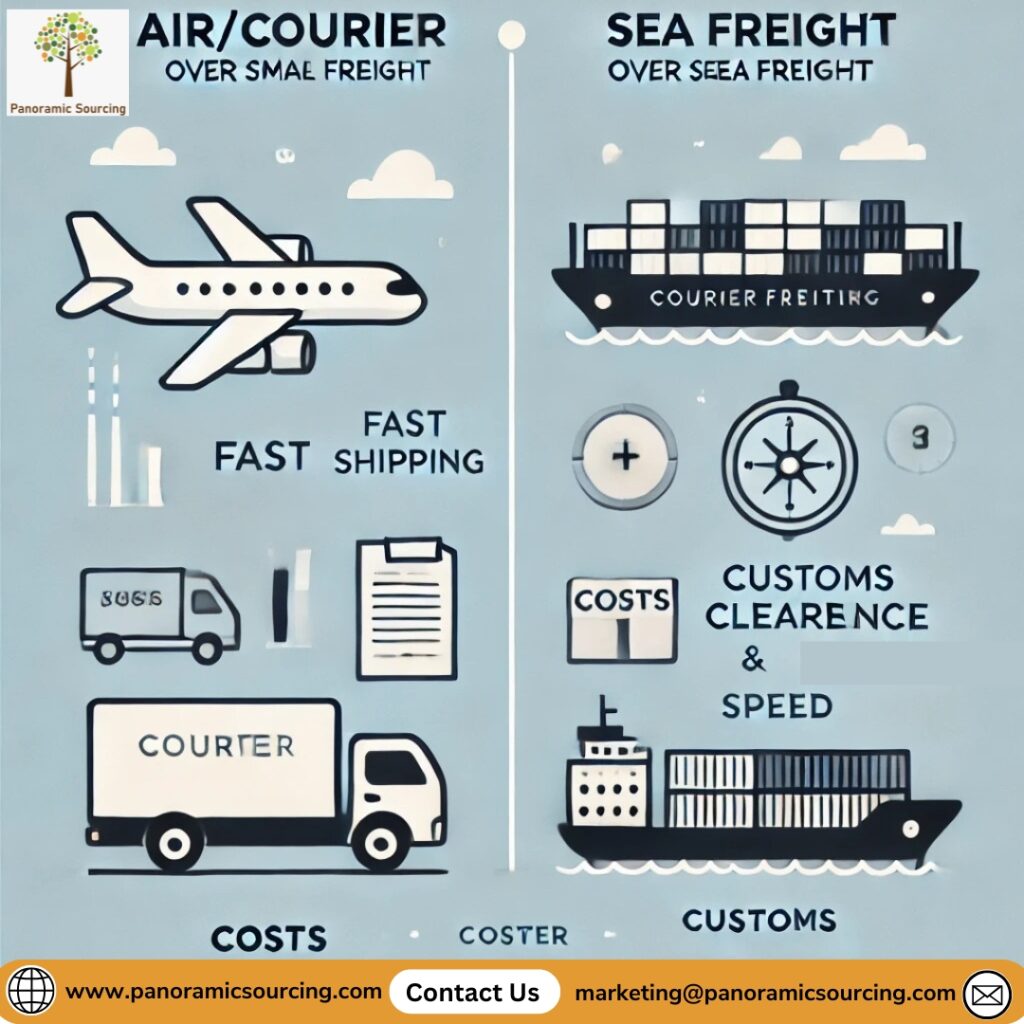In the world of international shipping, choosing the right mode of transport is crucial for businesses, especially when it comes to small shipments. Whether you’re shipping handcrafted products, leather goods, fashion accessories, or home furnishings, the choice between air/courier services and sea freight can have a significant impact on your bottom line. At Panoramic Sourcing, we understand the intricacies of logistics and work closely with clients to find the best solutions for their needs. In this post, we explore why small shipments are better suited for air/courier services over international sea freight.

1. Transport Costs from Factory to Port
When shipping small shipments, the cost from the factory to the origin sea port (e.g., Mumbai) can add up quickly. Typically, the minimum transport cost from a manufacturing city like Moradabad to the sea port is around $100. This cost applies regardless of whether the goods are shipped by air or sea. However, this cost becomes a larger burden when you’re shipping small orders. With sea freight, these costs can become disproportionately high, impacting the overall shipping price for small shipments.
2. Destination Port to Customer Warehouse (Trucking Costs)
For sea shipments, the trucking fees from the destination port to the customer’s warehouse in countries like the USA can be quite expensive. Depending on the distance, trucking costs can range from $600 to $1000. For small shipments, these additional trucking costs add up quickly and can make sea freight less economical.
3. Customs Clearance Costs
One of the biggest factors contributing to the higher cost of sea freight for small shipments is the customs clearance process. While air shipments typically incur a minimum customs clearance cost of around $100, sea shipments can have customs fees that are around three times higher. Sea shipments often carry a minimum clearance cost of approximately $300, while courier shipments (commercial) have much lower fees, typically around $50. These extra costs make sea freight a less desirable option for smaller shipments.
4. X-Works or Customer Responsibility for Small Shipments
For larger volume shipments, the shipper usually absorbs the origin port costs. However, for small shipments, these costs are often passed on to the customer. This means that customers are responsible for covering costs such as trucking and customs clearance at both ends of the journey. With sea freight, this can significantly increase the total cost of shipping small orders, making it less cost-effective compared to air or courier options.
5. Weight and Volume Considerations
Air and Courier Shipments: Air and courier shipments are generally charged based on either the actual weight or the volumetric weight (whichever is greater). This means you only pay for the space your goods occupy, making it a more fair and efficient pricing system, especially for small shipments.
Sea Shipments: Sea freight charges are primarily based on volume (cubic meters or CBM) of the shipment. For consumer durable goods, the minimum chargeable volume is typically around 1 CBM, which can lead to inflated costs for smaller shipments. This makes sea freight a less favorable option for smaller goods or low-volume shipments.
Why Air or Courier Shipments Are Better for Small Orders:
- Courier Mode: Courier services offer a convenient door-to-door service at mostly flat rates. These services are available for small shipments typically ranging from 30kg to 70kg. While there may be some additional fees for remote or residential areas, it remains an affordable and reliable option for small shipments, especially when compared to sea freight.
- Air Freight: For shipments ranging from 70kg to 150kg, air freight is often the best option. While air freight requires separate trucking charges from the origin airport to the customer’s warehouse, it is generally more cost-effective than sea freight. This is due to faster transit times and fewer hidden charges, making air freight a more efficient choice for businesses shipping smaller quantities.
Conclusion:
For small shipments (typically ranging from 30kg to 150kg), air and courier services are generally more cost-effective and efficient than sea freight. The reduced customs clearance costs, lower trucking fees, and faster transit times make air and courier services the ideal choice for businesses shipping smaller quantities. Whether you’re shipping handcrafted items, fashion accessories, or home décor products, choosing the right logistics solution can help you save on shipping costs and ensure faster delivery to your customers.
At Panoramic Sourcing, we specialize in sourcing solutions and logistics support for businesses worldwide. With over 25 years of experience, we ensure your shipments, large or small, are handled efficiently and cost-effectively. To learn more about how we can support your business, visit us at https://panoramicsourcing.com/logistics-support/.
Let Panoramic Sourcing be your trusted partner in making logistics smooth and efficient.
